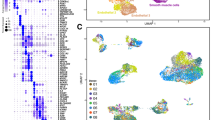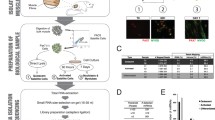Abstract
Adult skeletal muscle is a dynamic tissue able to regenerate quite efficiently, thanks to the presence of stem cell machinery. Besides the quiescent satellite cells that are activated upon injury or paracrine factors, other stem cells are described to be directly or indirectly involved in adult myogenesis. Mesoangioblasts (MABs) are vessel-associated stem cells originally isolated from embryonic dorsal aorta and, at later stages, from the adult muscle interstitium expressing pericyte markers. Adult MABs entered clinical trials for the treatment of Duchenne muscular dystrophy and the transcriptome of human fetal MABs has been described. In addition, single cell RNA-seq analyses provide novel information on adult murine MABs and more in general in interstitial muscle stem cells. This chapter provides state-of-the-art techniques to isolate and characterize murine MABs, fetal and adult human MABs.
Access this chapter
Tax calculation will be finalised at checkout
Purchases are for personal use only
Similar content being viewed by others
References
Kuang S, Kuroda K, Le Grand F et al (2007) Asymmetric self-renewal and commitment of satellite stem cells in muscle. Cell 129:999–1010
Cossu G, Biressi S (2005) In seminars in cell & developmental biology. (Elsevier) 16:623–631
Cassano M, Quattrocelli M, Crippa S et al (2009) Cellular mechanisms and local progenitor activation to regulate skeletal muscle mass. J Muscle Res Cell Motil 30(7–8):243–253
Agosti E, De Feudis M, Angelino E et al (2020) Both ghrelin deletion and unacylated ghrelin overexpression preserve muscles in aging mice. Aging (Albany NY) 12(14):13939–13957
Ronzoni F, Ceccarelli G, Perini I et al (2017) Met-activating genetically improved chimeric factor-1 promotes angiogenesis and hypertrophy in adult Myogenesis. Curr Pharm Biotechnol 18(4):309–317
Dellavalle A, Sampaolesi M, Tonlorenzi R et al (2007) Pericytes of human skeletal muscle are myogenic precursors distinct from satellite cells. Nat Cell Biol 9(3):255–267
Dellavalle A, Maroli G, Covarello D et al (2011) Pericytes resident in postnatal skeletal muscle differentiate into muscle fibres and generate satellite cells. Nat Commun 2:499
Quattrocelli M, Costamagna D, Giacomazzi G et al (2014) Notch signaling regulates myogenic regenerative capacity of murine and human mesoangioblasts. Cell Death Dis 5(10):e1448
Costamagna D, Quattrocelli M, van Tienen F et al (2016) Smad1/5/8 are myogenic regulators of murine and human mesoangioblasts. J Mol Cell Biol 8(1):73–87
Bonfanti C, Rossi G, Tedesco FS et al (2015) PW1/Peg3 expression regulates key properties that determine mesoangioblast stem cell competence. Nat Commun 6:6364
Breuls N, Giacomazzi G, Sampaolesi M (2019) (Epi)genetic modifications in myogenic stem cells: from novel insights to therapeutic perspectives. Cells 8(5):429
Pozzo E, Chai YC, Sampaolesi M. (2020) Comprehensive overview of non-coding RNAs in cardiac development. Adv Exp Med Biol 1229:197–211
Giarratana N, Conti F, La Rovere R et al (2020) MICAL2 is essential for myogenic lineage commitment. Cell Death Dis 11(8):654
Sampaolesi M, Torrente Y, Innocenzi A et al (2003) Cell therapy of α-sarcoglycan null dystrophic mice through intra-arterial delivery of mesoangioblasts. Science 301(5632):487–492
Sampaolesi M, Blot S, D’Antona G et al (2006) Mesoangioblast stem cells ameliorate muscle function in dystrophic dogs. Nature 444(7119):574–579
Quattrocelli M, Swinnen M, Giacomazzi G et al (2015) Mesodermal iPSC–derived progenitor cells functionally regenerate cardiac and skeletal muscle. J Clin Invest 125(12):4463–4482
Cossu G, Previtali SC, Napolitano S et al (2015) Intra-arterial transplantation of HLA-matched donor mesoangioblasts in Duchenne muscular dystrophy. EMBO Mol Med 7(12):1513–1528
Crisan M, Yap S, Casteilla L et al (2008) A perivascular origin for mesenchymal stem cells in multiple human organs. Cell Stem Cell 3:301–313
Ronzoni FL, Lemeille S, Kuzyakiv R et al (2020) Human fetal mesoangioblasts reveal tissue-dependent transcriptional signatures. Stem Cells Transl Med 9:575–589
Santoni de Sio FR, Gritti A, Cascio P et al (2008) Lentiviral vector gene transfer is limited by the proteasome at postentry steps in various types of stem cells. Stem Cells 26:2142–2152
Quattrocelli M, Giacomazzi G, Broeckx SY et al (2016) Equine-induced pluripotent stem cells retain lineage commitment toward myogenic and chondrogenic fates. Stem Cell Rep 6:55–63
Tonlorenzi R, Dellavalle A, Schnapp E et al (2007) Isolation and characterization of mesoangioblasts from mouse, dog, and human tissues. Curr Protoc Stem Cell Biol Chapter 2:Unit 2B.1
Barbuti A, Galvez BG, Crespi A et al (2010) Mesoangioblasts from ventricular vessels can differentiate in vitro into cardiac myocytes with sinoatrial-like properties. J Mol Cell Cardiol 48:415–423
Camps J, Breuls N, Sifrim A et al (2020) Interstitial cell remodeling promotes aberrant adipogenesis in dystrophic muscles. Cell Rep 31:107597
Picelli S, Faridani OR, Björklund AK et al (2014) Full-length RNA-seq from single cells using Smart-seq2. Nat Protoc 9:171–181
Breuls N, Giarratana N, Yedigaryan L et al (2021) Valproic acid stimulates myogenesis in pluripotent stem cell-derived mesodermal progenitors in a NOTCH-dependent manner. Cell Death Dis. 12(7): 677. https://doi.org/10.1038/s41419-021-03936-w. PMID: 34226515; PMCID: PMC8257578.
Butler A, Hoffman P, Smibert P et al (2018) Integrating single-cell transcriptomic data across different conditions, technologies, and species. Nat Biotechnol 36:411–420
Ronzoni FL, Giarratana N, Crippa S et al (2021) Guide Cells Support Muscle Regeneration and Affect Neuro-Muscular Junction Organization. Int J Mol Sci. 22(4):1939. https://doi.org/10.3390/ijms22041939. PMID: 33669272; PMCID: PMC7920023
Marini V, Marino F, Aliberti F et al (2022) Long-term culture of patient-derived cardiac organoids recapitulated Duchenne muscular dystrophy cardiomyopathy and disease progression. Front Cell Dev Biol. 10:878311. https://doi.org/10.3389/fcell.2022.878311. PMID: 36035984; PMCID: PMC9403515
Acknowledgments
Work in the authors’ laboratory is supported by The Research Foundation Flanders (FWO) (#G066821N), INTERREG – Euregio Meuse-Rhine (GYM, Generate your muscle 2020-EMR116), and Italian Ministry of Health, Ricerca Finalizzata (RF-2019-12369703). MS is recipient of Hercules Foundation grant (AKUL/19/34) for the financing provided to purchase the high throughput calcium imaging system.
Author information
Authors and Affiliations
Corresponding author
Editor information
Editors and Affiliations
Rights and permissions
Copyright information
© 2023 Springer Science+Business Media, LLC, part of Springer Nature
About this protocol
Cite this protocol
Giarratana, N., Conti, F., Rinvenuti, L., Ronzoni, F., Sampaolesi, M. (2023). State of the Art Procedures for the Isolation and Characterization of Mesoangioblasts. In: Asakura, A. (eds) Skeletal Muscle Stem Cells. Methods in Molecular Biology, vol 2640. Humana, New York, NY. https://doi.org/10.1007/978-1-0716-3036-5_8
Download citation
DOI: https://doi.org/10.1007/978-1-0716-3036-5_8
Published:
Publisher Name: Humana, New York, NY
Print ISBN: 978-1-0716-3035-8
Online ISBN: 978-1-0716-3036-5
eBook Packages: Springer Protocols




